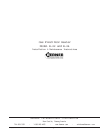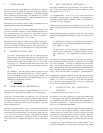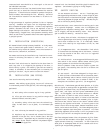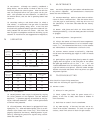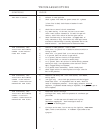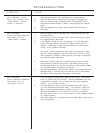
3
cross-sectional area should be at least equal to the sum of
the individual vent areas.
The outside end of the vent line should either have a weather-
proof vent cap or should be directed downward for weather
protection. It should also be screened to prevent foreign ma-
terial or insect s from entering the line. Naturally, the end of
the line should be located in an area where it is safe to re-
lease gas.
A high percentage of regulator problems is due to improper
venting. Remember the space over the diaphragm must be
able to breathe for proper regulation. If there is any regulation
problem, disconnect the vent line at the regulator to see if
proper venting is the solution. Then look for undersized lines,
crimped tubing, clogged lines, back pressure caused by draft
effect at end of vent or pressure effect from other regulators in
a grouped system.
VI. INSTALLATION (ELECTRICAL)
All internal electric wiring is factory installed. It is only neces-
sary to connect main power leads to terminals LI - L2 - L3 of
the tenminal strip inside the cabinet, and to wire between re-
mote station, doorswitch, and heater.
The remote station may be installed at any location for conve-
nience in switching the heater to “OFF” or “SUM” for warm
weather.
The door limit switch must be installed on the door frame in
such a way that it is tripped by the opening of the door. A
switch having 2 poles, one normally open and one normally
closed, is furnished, so that whichever pole is closed by the
opening of the door, may be used to actuate the heater.
VII. INSTALLATION (GAS PIPING)
(See Section Mounting Position Plumbing)
CAUTION: When making up gas piping, be sure all valves are
in a horizontal portion of the gas line, with valve body properly
positioned:
(A) Main safety valve actuator may be in any position.
(B) Pilot gas valve mounts in any position except with
solenoid inverted (vertically down).
(C) Secondary safety valve must have the solenoid up-
right, no more than 5º out of plumb, in a horizontal gas
line.
(D) Vent valve may be mounted in any position.
(E) Regulator may be removed and reinstalled further
upstream in the gas line, but no further than a few feet
from the heater. Regulators may be installed in any posi-
tion, except do not install a Maxitrol low pressure regula-
tor in a vertical-up gas line.
A manual cock (not furnished) should be piped in ahead of the
regulator. (See schematic piping on wiring diagram.)
VIII. SAFETY DEVICES
(A) Gas Pressure Switches*: Two U.L. listed gas pres-
sure supervising switches are used, to shut off gas if pres-
sure falls below or rises above the proper operating range.
(See wiring diagram for proper setting.) Switches are pre-
set at the factory during checkout.
Both switches have a vent connection for venting gas in case
of a ruptured diaphragm. Connect vent to atmosphere per
(Suggestions for Regulator Venting) above. The switches lock
out if tripped, and must be manually reset. Thus, whenever
gas is turned off manually, 1PS must be reset.
(B) Safety Shut-Off Valve: This heater is equipped with
a motor operated gas valve having closing spring that ex-
erts a force in excess of 5 lbs. It is a fast-open, instant
close valve meeting the requirements of FM, UL, AGA
and CSA.
(C) Hi-Temperature Limit: The “Thermodisc” limit switch
is located near the discharge end of the heater, mounted
on the top outside of the duct. This is a U.L. approved
manual-reset device.
(D) Airflow Switch: A UL-FM approved differential pres-
sure switch in the control cabinet senses velocity plus
static pressure of the airflow from the propeller.
This air pressure closes the switch contact to power the
gas system, thus assuring that the fan is on before the
gas can ignite.
(E) Gas Control: The flame safeguard is Fireye UVM- 1
F, which utilizes a flame scanner with an ultraviolet-sensi-
tive gas discharge tube to monitor visually both pilot and
main flame. At any time that it senses no flame, it de-
energizes the automatic gas valve. (UL-FM approved)
With this unit, if main burner goes off after ignition, or if pilot
fails to ignite at startup after an approximate 5-second trial-
for-ignition, an external relay (CR) de-energizes the flame safe-
guard (CRE), and lights the small green “TURN RESET” pilot
light. If this happens, turn the remote selector to “OFF/RE-
SET” then back to “WIN” to reset CR for another start. Re-
peated failure to ignite may result in lockout of the CRE flame
safeguard itself, causing small red “LOCKOUT” pilot to light.
This button must then be reset at the control cabinet before
another try-for-ignition can be made. If electric power to the
control circuit fails for any reason, whether intentional or oth-
erwise, and no matter how briefly, the flame safeguard gives a
safe-start component check when power is restored. If a flame
simulating component failure exists it will not proceed to the
ignition cycle and will not energize the main gas valve.
The flame safeguard senses first the presence of pilot flame.
Then, after the main automatic valve opens, the pilot is inter-
rupted and main flame only is monitored. If main flame fails
after pilot is interrupted there will be a 5 second trial for re-
ignition per 2nd preceding paragraph.



